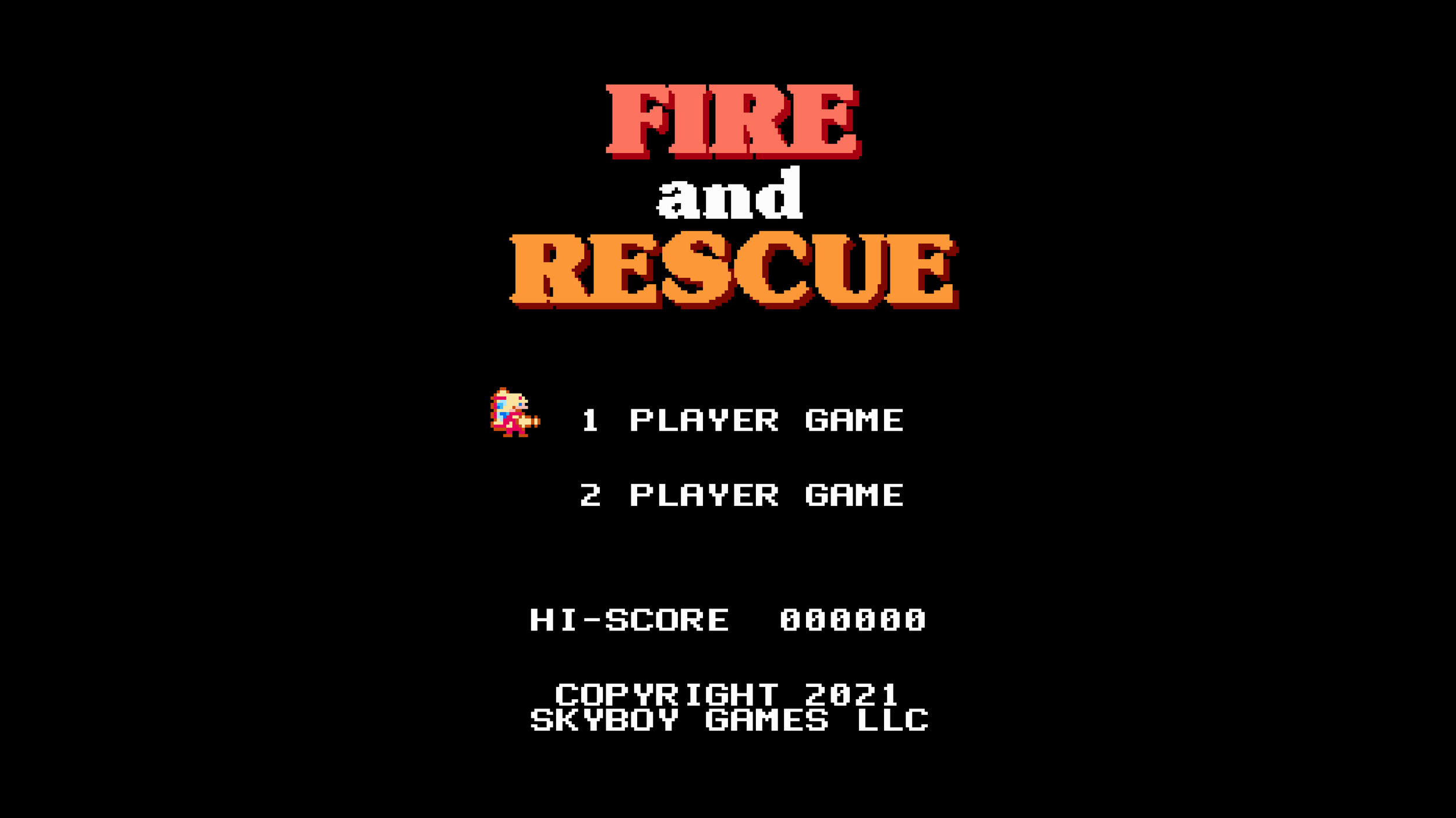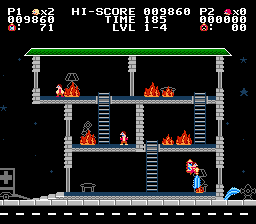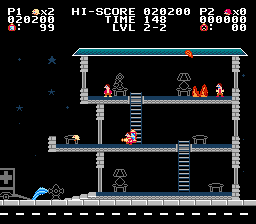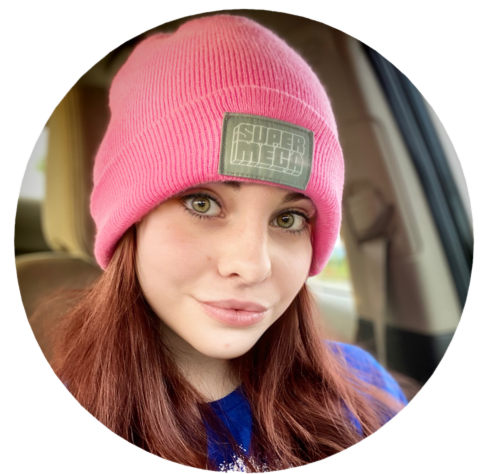FIRE AND RESCUE
The coolest part about Fire and Rescue is that there are physical NES cartridges available for this game with a box and game manual to boot! Yup, the developer actually sauders their own cartridges by hand. A ROM version of the game is also available. Honestly, I was surprised to see an NES game in the upcoming indies section at MAGFest but there seems to be a new wave of developers who are making new games for older consoles, which is awesome.
Fire and Rescue is reminiscent of 2-player team mode in Donkey Kong. The game is pretty simple: you are a firefighter and your task is to save the city from becoming a heap of ash. Once you get through a level you just progress to the next without any cutscenes. I asked the developer, Robbie Dieterich, why she decided to create a retro game and she said she did it because she just wanted to learn how to make games. Fire and Rescue is a pretty impressive start to her gamedev career if you ask me.
Robbie is also working on another unique retro arcade indie called Gunhawk. To play, you hold an NES controller in one hand and a gun from Duck Hunt in the other. Overall, I really enjoyed seeing the unconventional approach Skyboy Games has to creating “new retro” indie games.
Juan: What’s your name?
Robbie: So I'm Robbie Dieterich. I am the owner and founder of Skyboy Games.
Fae: Alright! So, what exactly is Skyboy Games? I've noticed that it seems to be like Super Nintendo, old-school gaming system-type things.
Robbie: Right, yeah. So Skyboy Games actually started, uhh, a while back is kind of just like, doing just kind of like independent development on the side.
Fae: Okay!
Robbie: And I actually come from the games industry. I've been in the games industry since like 2005 professionally.
Fae: Wow!
Robbie: I worked in Japan for about ten years as a programmer and lead programmer on various projects.
Fae: Okay.
Robbie: And I just started Skyboy Games on the side at some point, just as a place where I do, like, kind of independent game work, a little bit of contracting, here and there. And most recently, I've been teaching at George Mason University as a professor there of Game Design.
Fae: Wow!
Robbie: And probably about two years ago or so, I think (I’ve lost count since the pandemic), but I did a game jam called “The Lost Cartridge Jam”. With that one, it’s about forgotten games, or if you were to find some cartridge for a game you never heard of before.
Fae: Yeah.
Robbie: And I decided to try, uhh, try learning some homebrew development there. It was like a 72-hour jam challenge. I never really thought much about homebrew, so I thought, why not give it a try? And then I tried it. And I made something. I really, really, really like doing it. So I thought, okay, this is cool! Now I want to make a complete game. And so I did, and I took about eight months, but that's what became Fire and Rescue.
Fae: Okay.
Robbie: And so that was really fun to do, and still, at this point, mostly doing it because it entertains me. I put up the ROM and got a fairly decent reaction. And some people saying, “Hey, Are you going to do a physical version?” I'm like, “I don't know how to do that.”
Fae: (laughs)
Robbie: And when I said that, then basically, like, some people from the Homebrew community (or as we might as well call it, like the Indie NES Community) came in and basically, slid into our DM’s saying, “Hey, do you want to have a call?”. And this was, I think, Justin or Rich, who is just a really nice person in the scene. And we had this call where he spent a few hours telling me about all the stuff that I would need. Like, “Oh yeah, get a chip program at Amazon. I'd like to get microchips of this specification from eBay. These are the people that I like to go to the circuit boards and shells…” and so I started to get all the pieces together, and I learned how to solder.
Juan: So, made the cartridges yourself?
Robbie: I do. I make the cartridges myself!
Fae: Oh, my gosh! That’s wild!
Robbie: I had no idea that this was even possible, like something I could even do. At first, I would hate it. I thought, “Soldering, ahh, this is going to be a pain in the butt. I could maybe do 10 of these.” But then I did, and I thought, “I kind of like doing this.” It’s very zen. I just put on something like Star Trek or something and like work piece by piece. And so I started making physical versions and I started by putting up a website in order to sell them. And that’s worked out pretty well! I showed Fire and Rescue at MAGFest last year, and I happen to have ten physical copies that sold out!
Fae: Yay!
Robbie: And I thought, “This is incredible!”. And my wife says, “Maybe this isn't just a hobby, you know.”
Fae: Yeah!
Robbie: And so I'm doing it more, and now I’m working on the second project, which is still in development.
Juan: Is it Gunhawk?
Robbie: That’s Gunhawk, yeah!
Fae: Okay.
Robbie: That one is a combination zapper and gamepad game. A lot of these games are me reflecting on my childhood. Fire and Rescue was me thinking back to the Nintendo, which was the first system that I played as a kid. I wanted to make a game that felt like it fit right in the black box, like the original releases.
Fae: Yeah.
Robbie: And I actually thought of it specifically as, “What if it was one of the black box games?”. I looked at the portfolio of games and thought, “What is something thematically that they haven't done? What's something that's within the scope of, like, the technology that they're using?”. So the actual circuit board there is an actual end ROM board, which is the same kind of board that was used in the black box games — and it has the same type of specifications. And so it's very much trying to create something that was similar design-wise, feel-wise, and also thematically something that can fit within that portfolio.
Fae: Yeah.
Robbie: And with Gunhawk, basically, I’m a big anime and giant robot nerd.
Fae: Okay.
Robbie: So in my head cannon that game is a licensed game based on some obscure mecha anime that never made it to the states.
Fae: Oh!
Robbie: And then what we're seeing here is like we're just seeing the game brought over. So it's like, it's like, “Where did this come from? The design of all these things, they are a little bit more involved than just like a generic space shooter. Is this from something?” so I want to have a little bit of that mystery as we go into it. And finding ways to have fun with a zapper, which is a really interesting word for it.
Fae: Yeah, I bet that’s probably easier said than done to do with the whole zapper thing.
Juan: So, did you have to change your approach to game development since you’re working with those limitations now?
Robbie: Yeah, so, like, I found I really appreciate the limitations. So there are a couple of things that you really have to deal with here. First of all, there are all the graphical limitations in terms of, like, you know, you only have so many colors available at a certain point, you have a limited set of palette selections you can make, and it's kind of fun to be able to try to design graphics. It's like, “How can I make something that looks like anything within this limited eight-by-eight or sixteen-by-sixteen space? And I only have three colors to work with.” And I can kind of figure out how I can work around the limitations. “With an extra sprite here, I get an extra color, is it worth it performance-wise to do this?” So it’s kind of a big puzzle.
Juan: Yeah.
Robbie: In a lot of ways, I find that super enjoyable. But there are also a lot of cool tricks that you can only do because it was the old tech. Like in Gunhawk, for the moving background, I'm actually using a palette animation, which is you can basically change the colors that are assigned to certain graphics.
Fae: Oh, Okay.
Robbie: So that bottom floor isn't actually moving. It just changes colors in such a way makes it have the illusion that it’s moving toward you on the screen.
Fae: Yeah.
Juan: That is so cool!
Robbie: But it’s really fun to be able to do those effects because we don’t do them anymore because the technology is different.
Juan: It’s brute force everything out.
Robbie: Yeah, I mean, you just get to use all the colors.
Fae: (Laughs)
Robbie: I have 16 of them.
Fae: Yeah, right? (laughs)
Juan: You do all the art?
Robbie: Um, I do most of the art. So, all of the art for Fire and Rescue — all the sound, the art — I did everything myself. For Gunhawk, I've done most of the art but the musical track is from an artist named DV-i, who was actually DJing at MAGFest last night. She was the one who was like the final DJ on stage last night. She's really cool. DV-i.
Fae: Yeah! I’ve seen them.
Robbie: So she did the music for the game, and she also designed like the hud, like that top hud right on the screen. Which was really cool. And then, I took parts of it and repositioned it in different areas. She also did the buildings in the background in that game.
Fae: Okay, yeah!
Robbie: What was really cool was that I talked to her about the tile limitations, and she was like, “Okay, I gotcha.” And so she made six different tiles that we could rearrange in different buildings.
Fae: Perfect.
Robbie: So, yeah, genius. She’s super awesome too.
Fae: Yeah! (laughs)
Robbie: Gosh, yeah. And so here’s another good line that I have for you, which is something I've been saying to a lot of folks, so doing the programming for the Nintendo, I found that the compiler is like the best producer I've ever had. Because basically, whenever I keep adding things to the game, at some point, the compiler will say, “there's no more space. You can't add anything more. Unless you take something out. This cannot go in.”
Juan: Right, yeah. So every time you run your code, it's like telling you what you can and can't do.
Robbie: Pretty much. So actually, I was planning to have an upgrade system in the build for this build of GunHawk, and I was working on it last night, but I ran out of space to fit it into the ROM.
Fae: Oh no!
Robbie: And so I need to, like, kind of reconfigure all the parts and optimize things to make space for it. So it’s kind of like saying, “Hey, it’s too big of a risk. Calm down.” It's like the best producer I've ever had.
Fae: Oh, yeah!
Robbie: I wish some of my human producers helped me out as much as that compiler does.
Fae: Yeah.
Robbie: But yeah, it's a really great space to work with. And a lot of the people in the space — the Homebrew space — some people talk about trying to rebrand a little bit about how we refer to it. Because “Homebrew”, it makes sense for people who play games, it makes sense to you and me, but to a more general audience is maybe not as clear.
Juan: Yeah.
Robbie: Some people have been suggesting, “Well, how about a phrase like your console name plus indies? Like ‘NES Indies’.”
Fae: Oh, yeah.
Robbie: So I'm gonna see how that goes. That's a conversation that started last night.
Fae: Interesting!
Robbie: So things are like, there's a lot of exciting stuff going on.
Fae: Yeah, that's one thing that drew me is that it's interesting that it's on an old console.
Robbie: Right.
Fae: Because you don't normally see that. A new game on an old console.
Robbie: I know, there’s more than you'd expect. If you wander into that corner, there's the whole Homebrew section over there.
Fae: Oh, wow!
Robbie: That's actually been run by Mega Cat Studios, which is the studio over there. And they kind of cut their teeth on doing this kind of like NES Indie, HomeBrew type stuff. And their studio has actually gotten fairly large now. I talked to them earlier, and they were like, “Yeah, we have like 60 people.”
Fae: Woah! That’s so cool.
Robbie: Yeah!
Juan: So, are you selling your games anywhere online?
Robbie: Yes, I'm selling them at my site, SkyboyGames.com.
Juan: Okay.
Robbie: You can also find the ROMs to download on SkyboyGames.itch.io. You can find Skyboy games on the usual social media suspects like Twitter, Mastodon, and Instagram. Sometimes I’ll actually like to update my Facebook, too, because I want my parents to know how I’m doing.
Fae: (laughs) Yeah.
Robbie: We’re all on there. People can order physical copies of the game too. The new version of the physical version of Fire and Rescue, there’s actually a new trick on there, where there's actually an NFC chip. So if you use an NFC reader and hold it over the label of the cartridge, it will actually give you a link where you can download the ROM as well.
Fae: That’s so cool!
Juan: That’s awesome.
Robbie: It turns out the MC stickers are super cheap. And get up like 30 cents nowadays.
Fae: Yeah, right? (laughs)
Juan: Thanks so much for the interview!
Robbie: Yeah, my pleasure. Thank you so much!
coverage by
JUAN
coverage by
JENNIE HIPP
transcription by












